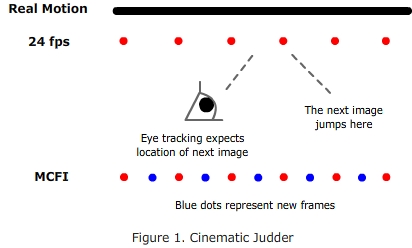Of flicker, judder and motion blurring…
The flicker phenomenon is perceived when light is being flashed causing the content of the screen to change. For example, flashing an image for just a fraction of a second will leave a blank screen for the remaining period until the next event.
The severity of the flicker phenomenon depends on the flashing rate of the display vs. the temporal sensitivity of the viewer; generally a lower rate will cause more flicker. Wider viewing angles (size of screen filling the visual area) and brighter images also tend to make flicker more noticeable.
I hesitate to use refresh rate to describe the flashing process (although the term is used interchangeably), because LCD’s don’t flicker with low refresh rates. Refresh rates for LCDs only measure how frequently the panel can be updated. This apparent contradiction comes from the way an LCD panel works. For a CRT, between every refresh process, images are shown for a very short time and then interposed with a blank screen. An LCD `holds’ the images all the way until the next frame update. This is the `sample and hold effect’; there is no flicker because no flashing or content change is involved.
LCDs are very good for static images or text and are the preferred choice for word and photo processing on a PC. CRTs need to have high rates (>85HZ) to reduce flicker but even then, there is a minority of people who can still experience it, causing fatigue and other side effects.

The two main causes of judder are frame rate conversion and motion-sampling (cinematic) judder. In real life, any motion over a period of time can be represented by an infinite sequence of still frames projected to the eye. In film recording, the current 24 frames per second are insufficient to simulate smooth motion at all speeds. Viewers will perceive judder when the eyes expect to track smooth movement but the film delivers the action in `jumps’.
The classic example of frame rate conversion judder is the application of 2-3 pulldown on 24 to 60 Hz process. Here, every second frame is repeated three times, causing a temporal ‘stutter’ at 12 beats per second. In the US, a similar NTSC judder have been in operation for years and tolerated, but in the UK, the 24 to 60 Hz conversion is a relatively new phenomenon since the introduction of gaming consoles and HD players. Viewers are likely to notice the judder when switching from PAL to the upconverted material.
You should be aware of the following points. Converting 24 Hz to 48 or 72Hz by frame repetition will eliminate the 2:3 pulldown stutter BUT not the inherent cinematic judder. To do that you need to create new `points’ or frames between the original 24 frames to allow smoother motion. So, using frame repetition or frame interpolation will depend on whether you enjoy the nostalgic cinematic feel or not.
Motion blurring (smearing, ghosting) is a problem with any technology that has the `sample -and-hold effect’. In the early years, LCD suffered more because of poor response times as well. (how fast crystals changed state). Overdrive technology has improved response times but for most LCDs, the above effect still remains.
The highest standard for motion portrayal lies in having more frames to represent motion without little or no sample-or-hold effect. For example, a high refresh rate CRT driven with 100Hz video would be very smooth and detailed.
In our Flash example above, the motion blurring and perceived lack of detail in LCDs during fast action is caused by the combination of the hold effect and image persistence of the eye. With the MCFI (motion compensated frame interpolation) tech, new frames are created between original frames. This clever process simultaneously limits the hold time and creates stutter-free motion. If this technology was applied to CRT (and it has), motion portrayal would be even more impressive.
MCFI tech at normal refresh rates (e.g. Philip’s Digital Natural Motion and Samsung’s Movie Plus) can reduce judder but not lessen the hold time dramatically.
This is the new standard for the LCD industry. My short experience shows enormous benefit with fast action video. Its usefulness in films is debatable but that will most likely come down to personal choice. Currently, I would only consider MCFI technology in 100 or 120 Hz, available in the Toshiba WLT68, Panasonic LXD70/700 and the upcoming Samsung 32 inch M86 series. Other manufacturers like Sharp and Sony are following suit with newer models infused with this exciting technology.